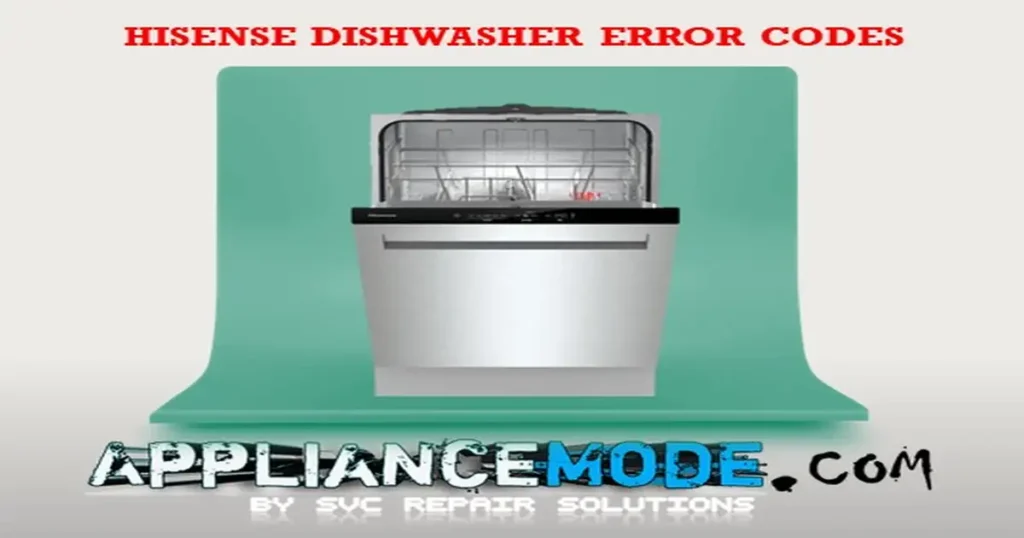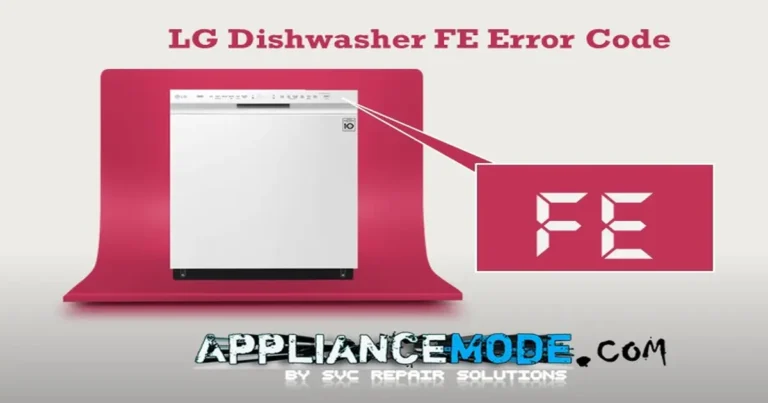Hisense Dishwasher Error Codes Explained: Your Troubleshooting Guide
Encountering an error code on your Hisense dishwasher can be frustrating, but understanding what these codes mean is the first step to a quick fix. This guide will help you diagnose and resolve common issues, ensuring your dishwasher returns to optimal performance.

Always remember to unplug your dishwasher and exercise caution when attempting any repairs.
| Error Code | Issue Description | Possible Solutions | Ohmic Value (Approximate) for Component | Abnormal Ohmic Reading |
|---|---|---|---|---|
| F10 | Overflow Error: Too much water detected in the dishwasher, exceeding normal limits. | 1. Examine wiring harness for loose connections/damage. 2. Inspect outlet hose for blockages/kinks. 3. Check water inlet valve for clogs/sticking (clean or replace). 4. Verify flowmeter operation. 5. Check float switch functionality (clean or replace). 6. Clear any clogs in the drain hose, pump, and filter. | N/A | N/A |
| F11 | Water Outlet Error: Drain pump is not effectively draining water. | 1. Examine the wiring harness for loose connections/damage. 2. Inspect the hydraulic sump for blockages. 3. Inspect the drain filter, drain hose, and pump for debris/blockages. 4. Clean coarse filter (if applicable). 5. Ensure that the yellow locking plug is properly connected. 6. Manually verify drain pump operation. 7. Check drain pump resistance. 8. If the problem persists, replace the main board. | Drain pump: 34 Ω @ 120V AC / 190 Ω @ 220V AC | 0.1-1.0 Ω or OL / ∞ Ω |
| F12 | Water Inlet Fault: Issue with the dishwasher’s water supply; insufficient water entering. | 1. Ensure the water supply is on and the pressure is sufficient. 2. Check the water inlet hose for kinks/damage and proper connection. 3. Clean the water inlet filter of debris/sediment. 4. Check the water valve for obstruction/malfunction. 5. Ensure the flowmeter is functioning correctly. 6. If the error persists, replace the main board. | Water Inlet Valve (Aqua-stop): 0.9 KΩ @ 120V AC / 4 KΩ @ 220V AC | 0.1-1.0 Ω or OL / ∞ Ω |
| F40 | Leakage on Inlet Valve Error: Leak detected around the water inlet valve. | 1. Check water inlet valve and connections for leaks (tighten/replace). 2. Check dishwasher tub and door gasket/seal for water accumulation/leakage (clean/replace gasket). 3. Ensure the flowmeter receives 5 Vdc (if not, replace the main board). 4. Check the pressure sensor. 5. If the error persists, replace the main board. | N/A | N/A |
| F41 | Heating Error: Issue with the water heating component. | 1. Check wiring/connections to heating element for damage/loose connections. 2. Inspect the heating element for visible damage (cracks, breaks). 3. Test heating element resistance with a multimeter (should be ~12 ohms). 4. Ensure the temperature sensor is accurately detecting temperature. 5. Check pressure sensor functionality. 6. Ensure the circulation pump is operating properly. 7. If the problem persists, replace the main board. | Heater assembly: 12 Ω @ 120V AC / 30 Ω @ 220V AC | 0.1-1.0 Ω or OL / ∞ Ω |
| F42 | Temperature Sensor Error: Dishwasher detected temperature outside acceptable range. | 1. Inspect wiring harness for loose connections/damage. 2. Ensure the temperature sensor is accurately measuring temperature. 3. If the problem persists, replace the main board. | NTC sensor: 10 KΩ @ 25 °C (77°F) | N/A |
| F43 | Pressure Sensor Error: Problem with the dishwasher’s pressure sensor. | 1. Check the wiring harness for loose connections/damage. 2. Ensure the pressure sensor is functioning correctly. 3. Verify control unit functionality (replace if error persists). | N/A | N/A |
| F44 | Turbidity Sensor Error: Issue with the component detecting dirt/food particles in water. | 1. Check wiring/connections to turbidity sensor for damage/loose connections. 2. Clean the dirty/residue-covered turbidity sensor. 3. Ensure the turbidity sensor is properly aligned/positioned. 4. Inspect the turbidity sensor for visible damage (replace if damaged). 5. If the problem persists, replace the main board. | N/A | N/A |
| F45 | Diverter Valve Error: Issue with the component directing water flow inside. | 1. Inspect the wiring harness for loose connections/damage. 2. Check the diverter valve for visible damage (cracks, leaks, debris) (replace if damaged). 3. Use a multimeter to check the resistance of its micro-motor. 4. If the problem persists, replace the main board. | Diverter valve: 3 KΩ @ 120V AC / 10 KΩ @ 220V AC | 0.1-1.0 Ω or OL / ∞ Ω |
| F52 | Water Level 1 Error: Problem with the dishwasher’s water level. | 1. Ensure the pressure sensor is accurately detecting the water level. 2. Check the water valve is supplying appropriate water. 3. Inspect the flowmeter for accurate water flow measurement. 4. Verify air gap mechanism functionality. 5. Ensure the drain hose is not obstructed/damaged. | N/A | N/A |
| F53 | Water Level 2 Error: Another problem with the dishwasher’s water level. | 1. Inspect the wiring harness for loose connections/damage. 2. Check the water valve is supplying appropriate water. 3. Inspect the flowmeter for accurate water flow measurement. 4. Clean filter (if applicable). 5. Ensure that the drain hose is not obstructed/damaged. 6. Ensure the drain pump is functioning correctly. | N/A | N/A |
| F54 | Float Switch Error: The float switch detects water accumulating in the dishwasher’s base. | 1. Check all hoses and connections for damage/leaks (tighten/replace). 2. Check the dishwasher’s base for water/excessive moisture (identify the leak source). 3. Check the door gasket and other seals for wear/damage/misalignment (clean/replace). 4. Clean the float switch and surrounding area. 5. Test float switch functionality (replace if not responsive). | N/A | N/A |
| F56 | Circulation Pump Error: Problem with the dishwasher’s circulation pump. | 1. Check the wiring harness for loose connections/damage. 2. Ensure that the circulation pump is functioning correctly. 3. If the problem persists, replace the main board. | Circulation pump: 61 Ω | 0.1 – 1.0 Ω or OL / infty Ω |
| CLN | Appliance Must Be Cleaned: Buildup of residue, food particles, or debris. | 1. Remove large food particles/debris from the dishwasher, filter, and spray arms. 2. Remove and thoroughly clean the filter. 3. Remove and rinse spray arms, dislodging debris from nozzles. 4. Run self-cleaning cycle with dishwasher cleaner or baking soda. 5. Wipe down interior surfaces (walls, door, gasket) with a damp cloth and mild detergent. | N/A | N/A |
Conclusion:
Understanding these Hisense dishwasher error codes empowers you to effectively troubleshoot and address common problems, ensuring the optimal performance and longevity of your appliance. While this guide covers many common issues, always refer to your specific dishwasher’s user manual for detailed instructions and safety precautions.

I am a master Appliance Repair technician with over 35 years of experience in the field. I am passionate about helping people troubleshoot their appliances and fix common problems. My website, appliancemode.com, provides a wealth of information on troubleshooting common appliance issues and deciphering error codes. This website aims to empower people to tackle appliance repairs themselves and save money on service calls.



